Today’s Contemplation: Collapse Cometh CLXXIV

To EV Or Not To EV? One Of Many Questions Regarding Our ‘Clean/Green’ Utopian Future, Part 2.
In Part 1 of this two-part Contemplation I argue that the recent trumpeting of electric vehicle (EV) car sales as a prologue to their imminent mass adoption and possibly ‘saving of the world’ from our errant carbon emission ways is more a projection of hope than reflective of realities behind some rather opaque curtains. This growth may continue as cheerleaders hope — at least for a bit longer, and thus appearing to support their assertions — but there exist some relatively strong headwinds suggesting it will not. Time of course will tell…
In attempting to peer behind or through the curtains one must consider: the pattern of previous technology bubbles created by intense mass marketing and purchases by early adopters; the evidence for the manipulation of sales growth statistics feeding into the narrative of widespread and growing adoption; and, the need for current growth to continue in light of resource constraints, a lack of infrastructure supports, government subsidy withdrawals, inflation impacts, and the cost concerns of purchasers (see this recent Bloomberg news article that highlights the international car rental agency Hertz Global Holdings unloading 20,000 EVs (about 1/3 of its U.S. EV fleet) due to higher repair costs, low demand, and reinvesting some of the sales dollars into ICE vehicles).
There is also growing skepticism towards the most marketed aspect of EVs: they are significantly better for the planet’s environment and ecological systems[1]. One needs to step well outside the Overton Window created by the marketing propaganda of retailers (and regurgitated by much mainstream media and most politicians) to gain a more balanced view of this widespread assertion. And this is where I begin this Contemplation…

Carbon tunnel vision has created a widely-accepted narrative where the most dominant and for many the only impact of concern surrounding transportation vehicles seems to be what exits the tailpipe of an internal combustion engine (ICE) vehicle and does not for an EV. This creates a very narrow, keyhole perspective that ignores the embodied energy and a wide variety of ecologically-destructive, hydrocarbon-based industrial processes that are necessary for the production, maintenance, and eventual reclamation/disposal of both types of vehicles.
As I point out in Part 1 of my series of Contemplations on carbon tunnel vision and energy blindness:
“…the following graphic demonstrates (with respect to particular aspects of the issue of ‘sustainability’) this tendency to narrow our perspective can prevent the acknowledgement of so many other aspects of our world — and the graphic only includes some of the many others that could be considered, such as land-system change and biogeochemical flows. Perhaps most relevant is that this tunnel vision keeps many from recognising that humans exist within a world of complex systems that are intertwined and connected in nonlinear ways that the human brain cannot fathom easily, if at all.
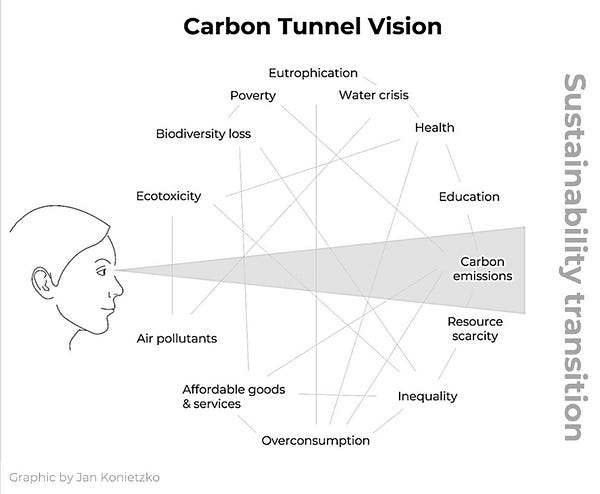
My own bias leads me to the belief that this hyper-focus on carbon emissions is leading many well-intentioned people to overlook the argument that atmospheric overloading is but one symptom predicament of our overarching predicament of ecological overshoot. As a result, they miss all the other symptom predicaments (e.g., biodiversity loss, resource depletion, soil degradation, geopolitical conflicts, etc.) of this overshoot and consequently advocate for ‘solutions’ that are, in fact, exacerbating our situation.
This rather narrowed perspective tends to be along the lines that if we can curtail/eliminate carbon emissions — usually through a shift in our technology to supposed ‘carbon-free’ ones — then we can avoid the negative repercussions that accompany the extraction and burning of fossil fuels, most prominently climate change. For many this is the only (or, at least, the most prominent) issue that needs to be addressed to ensure our species’ transition to a ‘sustainable’ way of living.
So, let’s try for a moment to open up this rather narrow keyhole and take in a wider perspective. Let’s look at how some of the other significant planetary boundaries are being broached.
When one opens the keyhole wider, the concern with carbon emissions/climate change may be seen as an outsized one in comparison to boundaries that appear to have been more significantly broached, such as: novel entities, biosphere integrity, land-system change, biogeochemical flows, and fresh water change.
This is not to say that the boundary of climate change is not important, it’s to try to better understand why a hyper-focus on carbon emissions is problematic: it’s one of several tipping points that need our attention, and not even the worst. The most pressing areas that we appear to have overshot beyond climate change include:
· Biogeochemical flows: agriculture and industry have increased significantly the flow of phosphorous and nitrogen into ecological systems and overloaded natural sinks (e.g., atmosphere and oceans)
· Novel entities: geologically-novel (i.e., human-made) substances that can have large-scale impacts upon Earth system processes (e.g., chemicals, plastics, etc.) have grown exponentially, even to the point of some existing in all global water supplies
· Biosphere integrity: human demand for food, water, and natural resources are decimating ecosystems (clearing land for mining and agriculture, for example, may have the worst impacts)
· Freshwater change: global groundwater levels in particular have been significantly altered by human activity and expansion (especially our drawdown of aquifers that exceed significantly their replenishment)
· Land-system change: human conversion of land systems (e.g., solar farms, agriculture, etc.) has impacts upon several of the other boundaries (i.e., biosphere integrity, biogeochemical flows, freshwater change) and the significantly important hydrological cycle
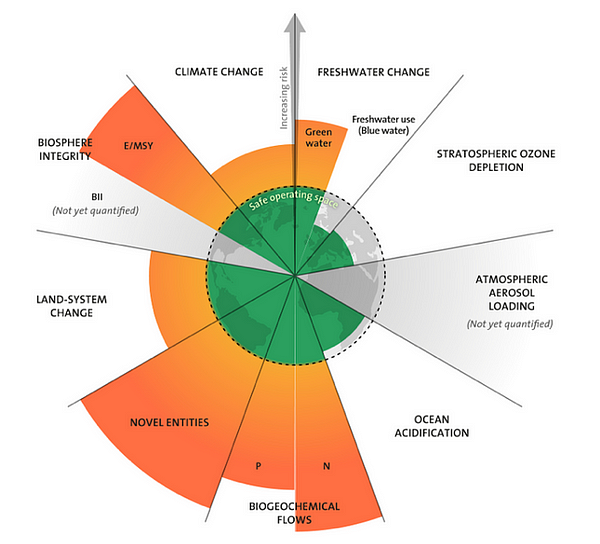
Carbon tunnel vision tends to help minimise, or at worst, ignore these other predicaments of our ecological overshoot. In fact, what I sense and what some of my conversations did suggest is that the issue of ecological overshoot itself is completely off the radar for these commenters. One, in fact, admitted he had never read Catton’s book on the subject but in ‘skimming over’ the summary notes I sent a link for he simply saw “a bunch of vague assertions…didn’t learn anything…probably heading towards a hard wall…”. He then added for effect: “I don’t see any solutions from you. I do see almost entirely your focus on smearing renewables with the exact same material the Deniers and carbon pollution people do. Exactly the same.””
Leaving aside the competing narratives regarding whether or not carbon emissions are in reality greatly reduced through the production and use of EVs[2] — perhaps mostly due to the source fuel for creating much of the world’s electricity that is necessary for powering EVs (hint: it’s hydrocarbons[3]) — for most critics of EVs the dominant issue is the massive mining that is required for the materials to construct the battery components for the storage of energy to run EVs[4].
Proponents of EVs tend to ignore the significantly destructive mining that is necessary and/or rationalise it away by arguing that mining can be carried out in a more environmentally-friendly manner[5], can be avoided through recycling[6], and/or future technological breakthroughs will drastically reduce its impact[7]. An example of this type of thinking is shared in a discussion at the end of this Contemplation.

Regardless of such hopefulness about future possibilities, mining is currently one of the most ecologically-destructive industrial processes performed by humans[8], and a lot must be carried out for the finite battery minerals necessary to store the electrical power required to run EVs[9] — to say little regarding all of the finite hydrocarbon inputs needed to carry this out[10] and the negative societal impacts that arise in areas where much of this mining takes place[11]. All of this potential additional mining has raised growing concerns about the ecological systems impacts of supposed ‘clean-energy’ vehicles[12], and in fact this is true for all non-renewable, renewable energy-based technologies (NRREBTs) that have been marketed as ‘green’ and ‘clean’.
Then there’s also how EVs will worsen plastic pollution in our ecological systems[13]. For a variety of reasons, but especially because they are heavier due to the weight of battery packs, the industry has increased significantly the use of plastic components in EVs[14]. Plastics, of course, are derived from petrochemicals. This graphic depicts the vast array of plastic components that help to create an EV. It is estimated that close to 50% of an EV’s volume is composed of plastic.
These hydrocarbon-based components are integral to the production of EVs and the industry argues that it is through the continued and expanded use of these hydrocarbon-based products that EVs will become even more efficient. (Note that the plasticisation of ICE vehicles has also been occurring[15] in an effort to reduce vehicle weight, avoid corrosion, and reduce costs).
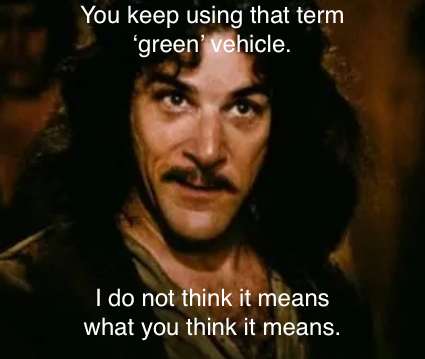
Add on top of this aspect that it has been determined that car tire and brake wear of all types of transportation vehicles are the primary cause of microplastic pollution[16]. Since EVs tend to be much heavier than ICE vehicles (due to their battery packs), the wear on these components is increased[17] leading to substantially increased microplastic pollution with EVs compared to ICE vehicles.
This particular petrochemical-based, plastic-pollution aspect is one that is rarely discussed and awareness of it needs to be raised since it appears our broaching of this specific planetary boundary (novel entities) is one of our most problematic (see graphic above), yet greatly ignored[18] — particularly when it comes to evaluating the ecological impact of EVs. EV advocates are quick to counter such issues with a reminder that it’s carbon emissions that is the most significant and/or only problem to be dealt with (e.g., don’t condemn the good looking for the perfect), minimising the harm caused by other aspects — a clear reflection of the carbon tunnel vision problem summarised above.
Further, as the curtain gets drawn aside with regard to the recycling industry and the myths that have surrounded it[19], it has become apparent that: only a portion of products actually get recycled, with a lot impossible to recycle and ending up in landfills; it requires large amounts of energy, perhaps not as much as the original product production but certainly not zero and in some cases more (and then there’s Jevon’s Paradox regarding how ‘efficiency’ savings are negated via increased demands); and, depending on what is being recycled and the processing necessary, there is much in the way of toxic pollutants created.
So, the argument that EVs and all or most of their components can be recycled and thus mining for its production can be significantly minimised falls far, far short of reality — to say little about the second law of thermodynamics and the related concept of entropy. And this is as true for ICE vehicles as it is for EVs; some of the components can be recycled (with associated ‘costs’) but much cannot — and this is particularly true for the hydrocarbon-derived, plastic components[20].
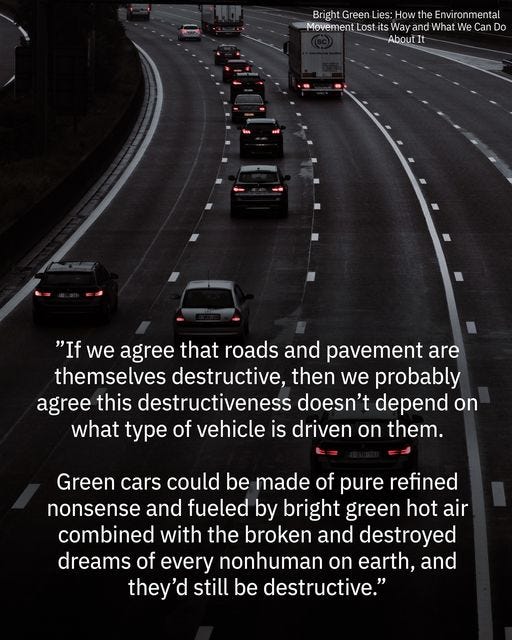
Despite narratives to the contrary, replacing billions of ICE vehicles with EVs will require significant quantities of hydrocarbon extraction, processing, and burning; the opposite of what EV cheerleaders argue is the primary reason for transitioning to them — to say little about all the hydrocarbons necessary to build and maintain/resurface the roadways these vehicles tend to travel upon, be they asphalt or gravel. Often, EV enthusiasts will counter this reality with arguments that the goal is to reduce the number of vehicles (particularly if they are ICE-based) on the road at the same time, thus mitigating the replacement problem.
This is not happening, however. The world is adding more and more vehicles every year[21], and the vast majority are ICE vehicles. EVs are, despite the ‘replacement-theory marketing hype’, becoming additive to our globe’s vehicles, not replacing the ICE fleet. Not surprisingly, this is exactly the same pattern with non-renewable, renewable energy-harvesting technologies (NRREHTs) such as solar panels and wind turbines — they are adding to our energy production, not replacing any of the hydrocarbon-based energy production they are supposedly meant to supplant[22].
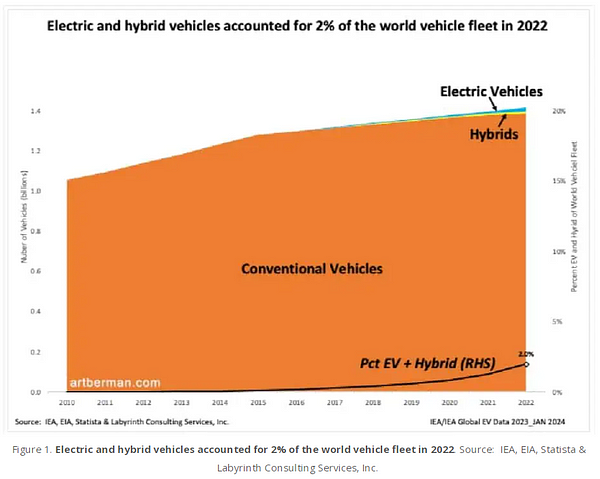
In fact, as energy analyst/petroleum geologist Art Berman argues in this article localities that have taken up large number of EVs (e.g., Norway, where 23% of their fleet was composed of EVs in 2022) have witnessed little to no impact on their overall hydrocarbon consumption. Despite repeated assertions that hydrocarbon demand will drop with the adoption of EVs, the data indicates this is simply false. Berman’s conclusion: “If you like EVs, you should buy one but the data don’t support that driving one will do anything to save the planet.”
It’s perhaps important at this juncture to recall the opening passage from an article authored by Dr. Bill Rees and Meigan Siebert critical of the entire mainstream energy transition narrative:
“We begin with a reminder that humans are storytellers by nature. We socially construct complex sets of facts, beliefs, and values that guide how we operate in the world. Indeed, humans act out of their socially constructed narratives as if they were real. All political ideologies, religious doctrines, economic paradigms, cultural narratives — even scientific theories — are socially constructed “stories” that may or may not accurately reflect any aspect of reality they purport to represent. Once a particular construct has taken hold, its adherents are likely to treat it more seriously than opposing evidence from an alternate conceptual framework.”
The construct that EVs are ‘green/clean’ and an important component of a global energy transition has been with us for the past couple of decades. It took a strong foothold as earlier emissions standards for an array of pollutants from vehicles and industry, as well as greater fuel efficiency, drove research[23] and subsequent narratives. With the realisation that there were technological limits to fuel efficiency improvements, it was suggested that the most ‘efficient’ engine would be the one that didn’t require traditional hydrocarbon fuel due to energy storage batteries as the ‘fuel’. An added ‘benefit’ would be the elimination of exhaust emissions (ignoring, of course, all the emissions created in the manufacture of the batteries, and/or the electricity to charge them). Thus, through the magic of mass marketing, was born the story that EVs were ‘clean’ and ‘green’.

There has been a concerted effort to spread this notion of EV ‘cleanliness’ far and wide, especially trumpeting the lack of tailpipe emissions. A majority of the ‘positive-outlook’ articles that arose in the wake of this have been from publications that are heavily slanted towards encouraging NRREBTs and/or the financing of/investing in them. These are, for the most part, individuals/businesses significantly ‘invested’ in seeing the rapid and widespread adoption of EVs and other ‘green/clean’ technologies. Their rhetoric is purposely slanted towards placing EVs in a positive light and then leveraging that perspective towards purchasers who may wish to ‘do the right thing’ where ‘the right thing’ is buying an NRREBT such as an EV.
This is Marketing 101: grow business revenue through the expansion of market share by getting the product front and centre for potential customers, particularly via the highlighting of features and/or benefits[24]. And when multiple billions (perhaps trillions) of dollars are up for grabs, multiple millions (perhaps billions) will be ‘invested’ in managing/guiding the narrative via all sorts of avenues — to say little about the mainstream media’s dependence upon funding in the way of advertising dollars, regardless of the ‘accuracy’ of what is being marketed via their product.
The massive and significant marketing propaganda we are constantly exposed to[25] about EVs and their ‘great-for-the-planet’ attributes have convinced a lot of people. The majority of these accept without question the positive aspects highlighted in commercial advertising or preached by EV cheerleaders. The illusory truth effect explains a lot of the power of this propaganda/advertising on beliefs: repeated exposure to information regardless of its validity/reliability comes to be perceived as truthful, primarily because familiarity overpowers rationality. This is why many hundreds of billions (perhaps trillions when one includes ‘public relations’ work/agencies/departments for corporations and governments) of dollars are ‘invested’ annually in advertising and narrative management — it works to impact belief systems and thus behaviour[26].
I would argue that consumers are additionally more prone to such narratives to help alleviate and/or reduce the cognitive dissonance that arises from a growing awareness that industrial civilisation is unsustainable and destructive to ecological systems (i.e., infinite growth — that we are continuing to pursue/experience — is impossible on a finite planet and has significant negative repercussions) yet wishing to also believe that human ingenuity and our technological prowess can overcome and ‘solve’ the predicament of human ecological overshoot and/or its symptom predicaments (e.g., biodiversity loss, resource depletion/scarcity, etc.)[27].

A part of me additionally believes that the narrative that EVs can be part of some grand ‘solution’ to our ecological overshoot predicament and its various symptom predicaments is the mind’s attempt to not only reduce anxiety-provoking thoughts but cling to the notion that we all have agency in/control over a very uncertain future[28]. We story-telling apes are creating tales to support such belief systems and reduce our anxiety. Perhaps buying an EV is subsequently not really about addressing environmental concerns; it’s about telling ourselves a comforting tale and engaging in some virtue-signalling to others to help us maintain our self-image as thoughtful, caring beings with agency over our future[29].
Personally, I view technocornucopian perspectives as delusional in a world of significant human ecological overshoot where the surplus energy to continue pursuing growth and such complex technologies is quickly disappearing[30] (if not already exhausted). We have for some time been pulling growth from the future via financial/monetary machinations and supported by geo/political gamesmanship (i.e., wars over resources and market control)[31].

That governments are not only complicit but encouraging the deception about EVs and NRREBTs being ‘green’ perhaps says a lot about their stake in the narrative. And what is a government’s incentive? Aside from the need in a debt-/credit-based economic system to chase perpetual growth to avoid ‘collapse’, this may be just another racket being perpetrated on the masses as U.S. Marine Corps Major General Smedley Butler suggested war is.
For myself, I tend to gravitate towards the entire energy transition narrative (of which EVs are but one component) being another in a wide array of profiteering rackets, leveraging the growing evidence and recognition that Homo sapiens are having a profoundly negative impact on the planet’s ecological systems. And those that are benefitting from this story will disseminate and protect it vociferously. Others, well, they’re caught up in the narrative/propaganda.
Given the Ponzi-type nature of our monetary/financial/economic systems, geopolitical stressors, resource constraints, and ecological concerns, one has to wonder just how far and how long the uptake of these NRREBTs can or will continue. In fact, some are arguing that the wheels have already fallen off with increasing numbers of planned projects being paused/cancelled[32]. And despite all the marketing and shouting from rooftops that the EV market is exploding, the sheen appears to be coming off the EV narrative.
Michael Shedlock begins this article with: “The market for used EVs is plummeting. What will car rental companies do with the used ones? Problems started in China but have spread to Europe and the US.” Citing a Bloomberg article, he highlights that “A subsidy-fueled boom helped build China into an electric-car giant but left weed-infested lots across the nation brimming with unwanted battery-powered vehicles.”
In this article economist Stephen Moore is quoted as stating: “The Edsel was one of the great flops of all time. I’m here to tell you, if these trends continue, we’re going to see the EV market become the next big flop because car buyers don’t want them.”
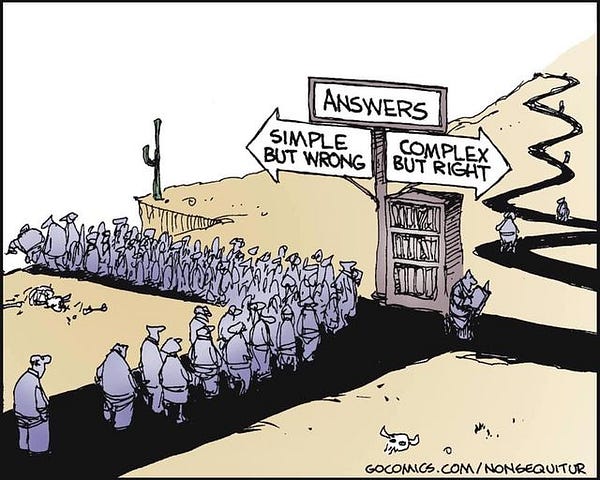
Let’s dispense with the binary narrative that is often on display and be perfectly clear and honest for a moment. Both EVs and ICE vehicles — along with all the infrastructure supports necessary for their production and use — are detrimental to our significantly important ecological systems. The continuing production and use of one, the other, or both simply exacerbates the human ecological overshoot predicament.
Once again, while the future cannot be predicted with much accuracy, the current reality is much, much different than the bargaining being carried out by those wishing to see a shift from ICE vehicles to EVs — particularly given that the environmental advantages cheerleaders crow on about are mostly founded upon as-yet-to-be-hatched-technologically-improved-and-massively-scaled-up chickens. These potential breakthroughs/improvements may or may not come to fruition. Most likely they will not make it much beyond a research lab or marginal prototype use, and believing otherwise is akin to faith/hope/wishful thinking; it is certainly not reflective of current realities.

We are being convinced by growth profiteers and their narrative managers that ‘smart’ or ‘green’ or the ridiculously oxymoronic notion of ‘sustainable’ growth is the way to maintain ‘progress’ and that human ingenuity, especially where technology is concerned, will extricate us from any and all issues we encounter along this inevitable path. We are not abiding by the precautionary principle and erring on the side of caution, however; not even close. We are travelling full-steam ahead and creating rationalisations/justifications in our story-telling manner to make us feel good about our suicidal behaviour and actions, thereby reducing our cognitive dissonance.
Without a significant, and likely expedient, reduction of both types of vehicles (that we are very unlikely to do voluntarily), there is little point in bargaining ploys to keep the status quo from continuing for as long as possible which seems to be what the narrative around an energy ‘transition’ and the adoption of NRREBTs is.
I had written a suggestive path forward on this issue that might provide some mitigation by avoiding the exacerbation of our destructive tendencies but in reflection see little point in sharing it. Given the human proclivity to pursue the business-as-usual scenario painted by Meadow’s et al. in The Limits to Growth over the past handful of decades[33], I’m certain any guideline would not be pursued and it would simply be cathartic for me.
While most want ‘solutions’ to our overshoot predicament, this demonstrates a weak understanding of not only what a predicament is (it has no ‘solution’) but also displays energy/resource blindness and denial of the ongoing ecological systems destruction that accompanies all complex technological ‘solutions’. The best mitigation any of us can pursue is a dramatic reduction in our consumptive and excessive tendencies.
The best vehicle in terms of reducing damage to our planet is the one not produced, regardless of type. If reducing one’s dependency upon and/or use of a well-maintained ICE vehicle can help to prevent the production of a new vehicle (of either type), then the negative ecological systems damage that accompanies the creation of transportation vehicles is reduced dramatically. Reducing dependence upon and/or use of an ICE vehicle (to zero if at all possible) will likely go much further than purchasing an EV.
You are not a progressive steward of the environment with your purchase or heralding of an EV (or related NRREBTs). That is a narrative we story-telling apes have weaved in order to avoid reality and reduce our anxieties, engaging in denial and massive magical thinking/bargaining along the way. As I’ve said numerous times, we are an intelligent species just not very wise.
The bottom line is as I commented on a recent FB post regarding supposed misinformation about EV battery ‘facts’: Substituting one resource-intensive and complex (and thus environmentally destructive) technology for another fully and completely overlooks humanity’s fundamental predicament of ecological overshoot, and is more about reducing one’s cognitive dissonance than anything else.
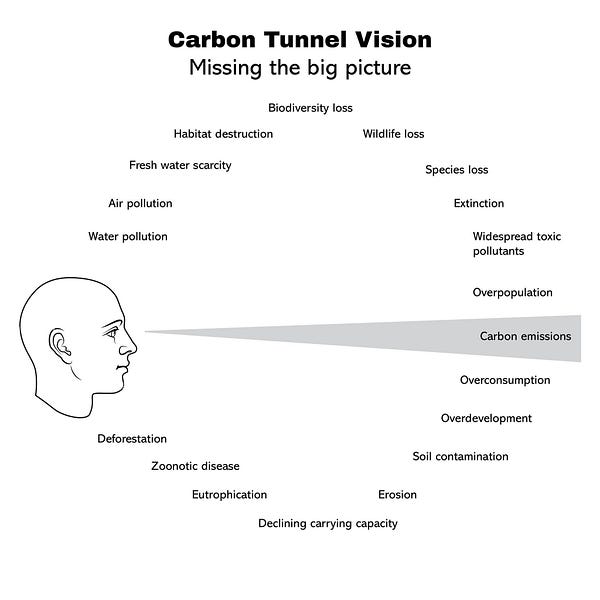
A handful of other ecological variables that could be added: land system changes, resource depletion, food scarcity, biosphere integrity, climate change, novel entities, stratospheric ozone depletion. Then add on top of this massive ecological complexity all the socioeconomic and sociopolitical systems that Homo sapiens have created that exacerbate our ecological overshoot.
Here is the discussion that I referred to above that demonstrates the magical thinking some engage in regarding the energy transition being touted by many. It was in response to this posted article.
Me: It would seem we need to destroy our ecological systems to save them…hmmmmmm.
UB: I am always in favor of creative disruption. It is the very concept of “Seneca Cliff,” normally followed by a “Seneca Rebound”
D: With a sad caveat the Good Doctor has pointed at: it must be not that much fun to be creatively disrupted 😉
Me: The one aspect of this energy ‘transition’ that seems to be invariably left out of the equation is the massive and significant destruction that would and is being wrought on the planet (and a planet with already very overloaded sinks). The scale of the mining and processing that is being considered (and requiring a gargantuan pulse of fossil fuel extraction and burning) would surely put us over (if it hasn’t already) any tipping point from which our planet could recover from (let alone Homo sapiens survive, or many other species for that matter). I’ve not seen anywhere a detailed consideration or analysis of this particular perspective; except to mostly dismiss it via omission of the issue.
E: Sorry Steve Bull — but mining for the energy transition will NOT destroy the biosphere. The “Energy Transitions Commission” is a huge global think tank. They estimated the entire energy cost to mine and build the entire Energy Transition over the next decades. The total thing will release about 4.5 to 9 months of today’s global annual emissions. Once. Fossil fuel emissions will have stopped forever. (Figures here — but I converted to months equivalent CO2 emissions for ease of comparison.)
But it will create too much mining?
From the link above: “Between 2022–2050, the energy transition could require the production of 6.5 billion tonnes of end-use materials, 95% of which would be steel, copper and aluminium which the energy transition will require,”
Again — fossil fuels are 14 billion tons EVERY year.
What about all the raw rock and ore crunched to extract all those metals? It’s still not as bad as fossil fuels. https://www.sustainabilitybynumbers.com/p/energy-transition-materials
Me: We will have to agree to disagree.
Sure, a ‘think tank’ composed of people with very vested (financial) interests and focused on economic growth is guaranteed to be providing objective opinions based on very sound research and models.
It’s a great (cognitive dissonance-reducing) narrative but given how far into ecological overshoot the human species has travelled, whether it is death by a 1000 cuts or 999 or even 900 is truly moot. Both are ultimately suicidal when sustaining ‘growth’ is the fundamental driver (even if it’s not, maintaining the status quo is equally problematic given the amount of resource drawdown it requires).
The most appropriate path would be to attempt to reduce (significantly) all our complex technologies (along with other things like population) rather than attempt to carry on with business as usual via non-renewable, renewable energy-based industrial products.
If you’ve made it to the end of this contemplation and have got something out of my writing, please consider ordering the trilogy of my ‘fictional’ novel series, Olduvai (PDF files; only $9.99 Canadian), via my website or the link below — the ‘profits’ of which help me to keep my internet presence alive and first book available in print (and is available via various online retailers).
Attempting a new payment system as I am contemplating shutting down my site in the future (given the ever-increasing costs to keep it running).
If you are interested in purchasing any of the 3 books individually or the trilogy, please try the link below indicating which book(s) you are purchasing.
Costs (Canadian dollars):
Book 1: $2.99
Book 2: $3.89
Book 3: $3.89
Trilogy: $9.99
Feel free to throw in a ‘tip’ on top of the base cost if you wish; perhaps by paying in U.S. dollars instead of Canadian. Every few cents/dollars helps…
https://paypal.me/olduvaitrilogy?country.x=CA&locale.x=en_US
If you do not hear from me within 48 hours or you are having trouble with the system, please email me: olduvaitrilogy@gmail.com.
You can also find a variety of resources, particularly my summary notes for a handful of texts, especially Catton’s Overshoot and Tainter’s Collapse: see here.
It Bears Repeating: Best Of…Volume 1
A compilation of writers focused on the nexus of limits to growth, energy, and ecological overshoot.
With a Foreword and Afterword by Michael Dowd, authors include: Max Wilbert; Tim Watkins; Mike Stasse; Dr. Bill Rees; Dr. Tim Morgan; Rob Mielcarski; Dr. Simon Michaux; Erik Michaels; Just Collapse’s Tristan Sykes & Dr. Kate Booth; Kevin Hester; Alice Friedemann; David Casey; and, Steve Bull.
The document is not a guided narrative towards a singular or overarching message; except, perhaps, that we are in a predicament of our own making with a far more chaotic future ahead of us than most imagine–and most certainly than what mainstream media/politics would have us believe.
Click here to access the document as a PDF file, free to download.
[1] See this, this, this, and/or this.
[2] See this, this, this, this and/or this.
[4] See this, this, this, this, and/or this.
[5] See this, this, this, and/or this;.
[6] See this, this, this, and/or this.
[7] See this, this, this, and/or this.
[8] See this, this, this, and/or this.
[9] See this, this, and/or this.
[10] See this, this, this, this, and/or this.
[11] See this, this, this, and/or this.
[12] See this, this, this, this, this, this, this, and/or this.
[15] See this, this, this, this, and/or this.
[16] See this, this, this, and/or this.
[17] See this, this, this, and/or this.
[18] See this, this, and/or this.
[19] See this, this, this, this, this, this, this, this, this, this, and/or this.
[20] See this, this, this, this, this, this, and/or this.
[21] See this, this, this, and/or this.
[22] See this, this, this, and/or this.
[24] See this, this, this, this, and/or this.
[25] It’s hilarious, in a very sad way, that the advertisements that flood my Facebook feed are almost entirely focused upon non-renewable, renewable energy-harvesting technologies (e.g., wind turbines, solar panels) and electric vehicles. This is perhaps because I occasionally comment on these posts. What the FB algorithms seem to be missing, however, is that my comments are quite critical of the assertions being made in the ads.
[26] See this, this, this, this, and/or this.
[28] See this, this, this and/or this.
[29] See this, this, this, and/or this.
[30] See this, this, and/or this.
[31] See this, this, this, and/or this.